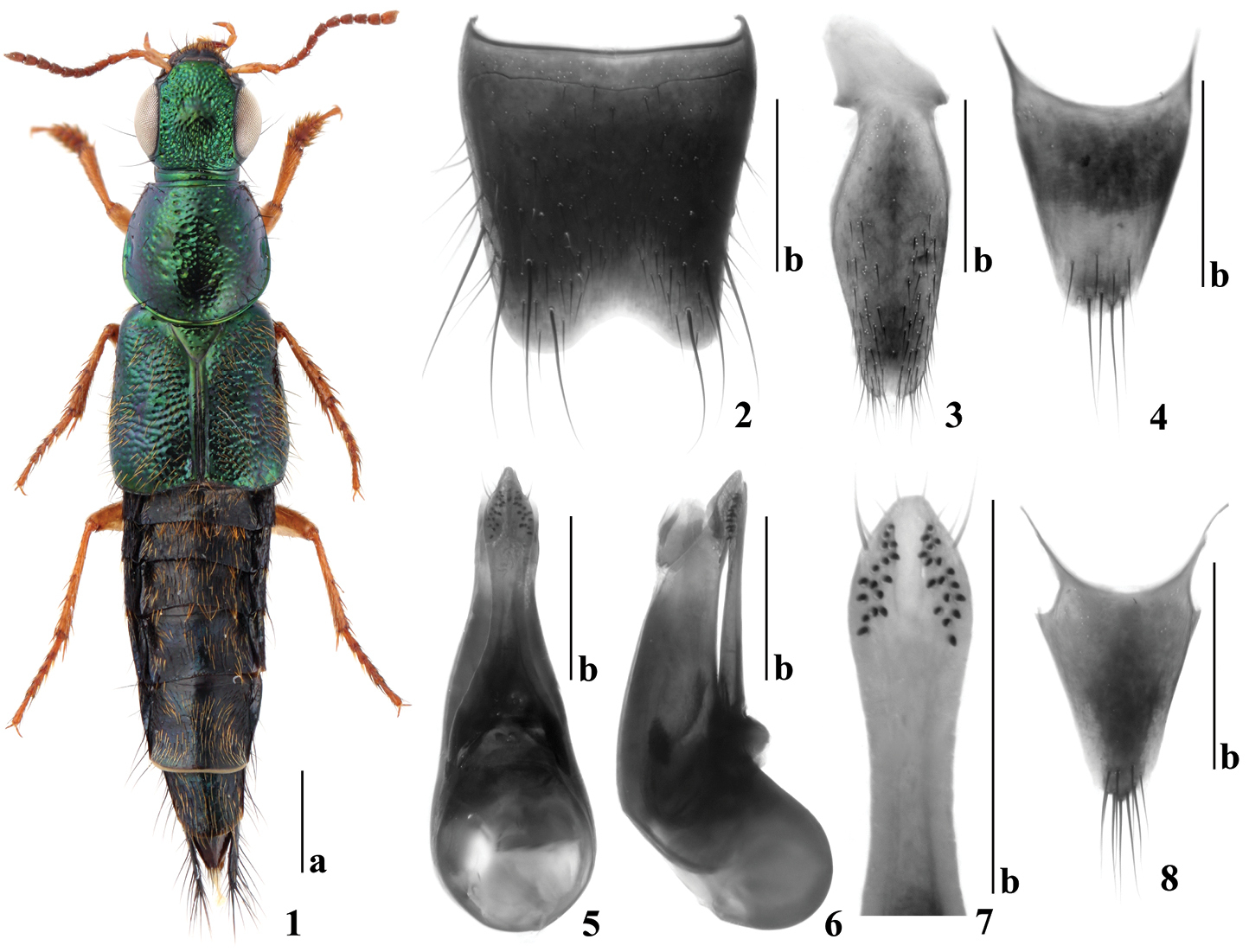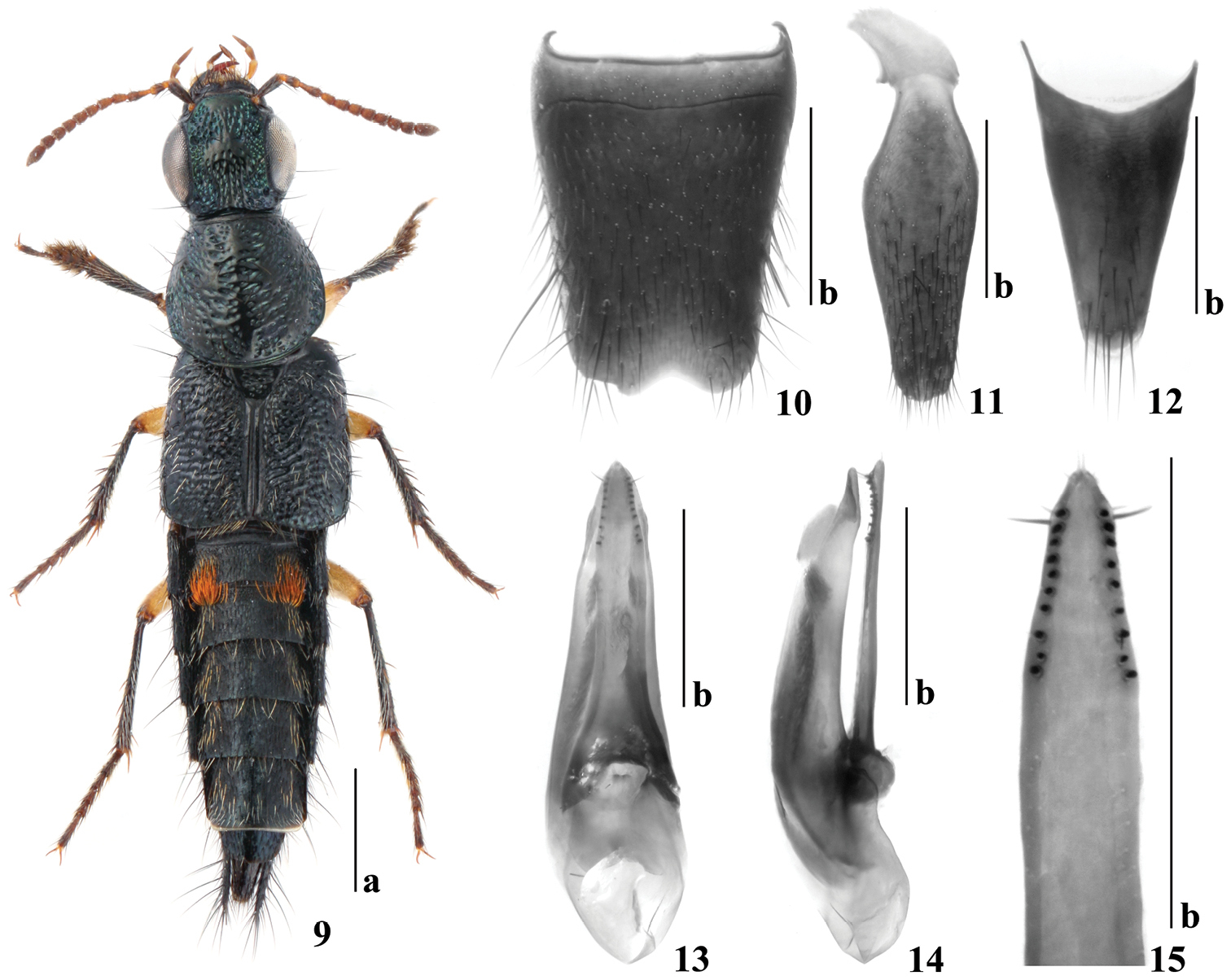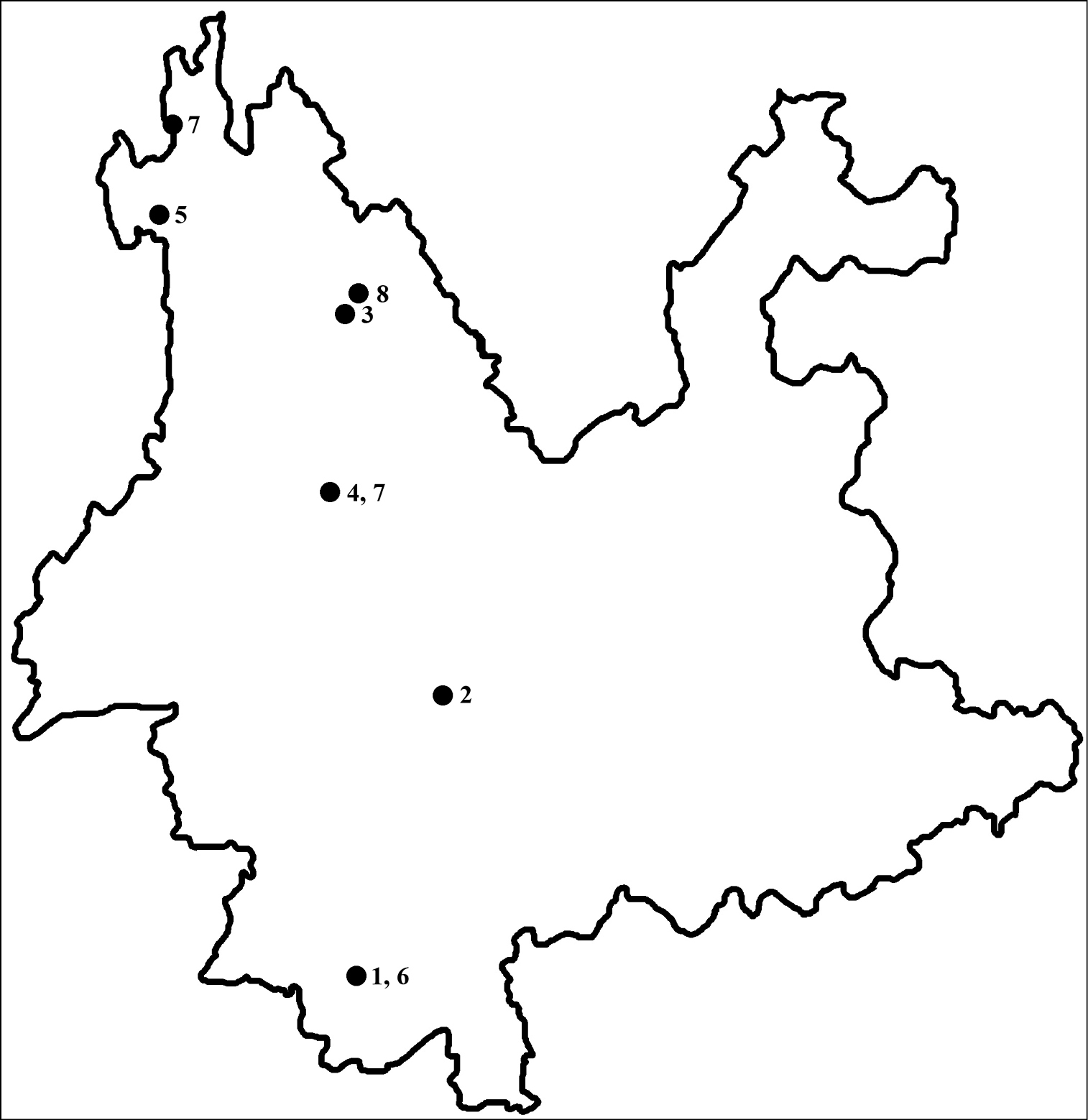






(C) 2012 Jia-Yao Hu. This is an open access article distributed under the terms of the Creative Commons Attribution License 3.0 (CC-BY), which permits unrestricted use, distribution, and reproduction in any medium, provided the original author and source are credited.
For reference, use of the paginated PDF or printed version of this article is recommended.
Two new species of the genus Quedius Stephens collected from Nabanhe Nature Reserve, Yunnan Province, Quedius nabanhensis sp. n. and Quedius maoxingi sp. n., are described and illustrated. Keys to the multipunctatus group and intricatus group of Quedius species of Yunnan are provided. A map of the collecting sites is given.
Coleoptera, Staphylinidae, Staphylinini, Quedius, key, Yunnan, Southwest China, new species
To date, about 50 species of the genus Quedius Stephens, 1829 have been known from Yunnan Province, China (
The specimens were collected by sifting from wet moss on rocks in streams. They were killed with ethyl acetate and dried. The sternites, tergites and aedeagi were mounted in the Euparal on plastic slides. The habitus photos were taken with a Canon 40D camera. The photos of the sternites, tergites and aedeagi were taken with a Canon G9 camera mounted on an Olympus SZ61 stereoscope.
MeasurementsBody length: measured from the anterior margin of the labrum to the end of abdomen;
Forebody length: measured from the anterior margin of the labrum to the elytral apices;
Head length: measured from the apical margin of the head capsule to its posterior margin;
Head width: Maximal width of the head across eyes;
Eye length: longitudinal length of the eye in dorsal view;
Tempora length: length of the tempora in dorsal view;
Pronotum length: measured from the front margin of the pronotum to its posterior margin along the imaginary median line;
Pronotum width: width of the pronotum across its widest part;
Elytral width: width of the elytra at base;
Elytral length at suture: measured from the apex of the scutellum to the apex of suture;
Elytral length at lateral margins: measured from the humeral angle to the elytral apex.
Descriptionsurn:lsid:zoobank.org:act:39047DBA-1AD7-44D0-9C0F-CBB27EB8A71B
http://species-id.net/wiki/Quedius_nabanhensis
Figs 1–8Holotype. CHINA: Yunnan Prov.: male, Jinghong City, Nabanhe Nature Reserve, Bengganghani, Huazhulianshan, alt. 2, 300 m, 29-IV-2009, Jia-Yao HU & Zi-Wei YIN leg. Paratypes. 3 males, 3 females, same data as holotype.
Body length: 8.0–8.6 mm; forebody length: 4.1–4.3 mm.
Body (Fig. 1) shiny, head, pronotum and elytra bright metallic green, abdomen black and iridescent; appendages yellowish brown, antennae slightly darkened from base toward apex.
Head slightly wider than long (ratio 1.18); eyes large and convex, tempora distinctly shorter than eyes from above (ratio 0.18); dorsal surface of head with coarse and dense punctation, becoming finer toward vertex and clypeus; surface with fine and dense microsculpture of transverse waves, becoming almost meshed anterior to vertex. Antennae slightly widened apicad, segments III slightly longer than II, segments IV–IX longer than wide, gradually becoming shorter, segments X about as long as wide, last segment as long as two preceding segments combined.
Pronotum about as long as wide; dorsal rows each with seven to eight coarse punctures, forming irregular row; sublateral rows each expanded into irregular group of seven to ten punctures; some distinctly finer punctures scattered among coarse punctation; surface with fine and dense microsculpture of transverse waves. Scutellum with nine to fourteen fine punctures, with fine microsculpture of transverse waves. Elytra at base about as wide as pronotum at widest point, at suture slightly shorter (ratio 0.84), at lateral margins slightly longer (ratio 1.35) than pronotum at midline; punctation coarse and dense, almost confluent and forming transverse rugae; pubescence yellowish-golden; surface without microsculpture. Wings fully developed.
Abdomen with tergite VII bearing distinct whitish apical seam of palisade fringe; punctation moderately fine and dense; pubescence black, each tergite with some scattered golden pubescence; surface with fine and dense microsculpture of transverse waves.
Male. First four segments of protarsus distinctly dilated. Sternite VIII (Fig. 2) with four long setae on each side, with wide, shallow, arcuate medioapical emargination. Sternite IX (Fig. 3) slightly notched in medioapical emargination, with two differentiated apical setae. Tergite X (Fig. 4) with several apical setae. Aedeagus (Figs 5–7) with median lobe gradually narrowed into cone-shaped apex; paramere not reaching apex of median lobe, in ventral view distinctly narrowed at middle and slightly widened near apex; with two apical setae, two similar setae and one long seta at each lateral margin below apex; underside of paramere with sensory peg setae arranged into two longitudinal areas, each with 16–17 peg setae.
Female. First four segments of protarsus similar to those of male, but distinctly less dilated. Tergite X (Fig. 8) with several apical setae.
Known only from the type locality (Southwest China: Yunnan Province).
Quedius nabanhensis is closest to Quedius xeno Smetana, 1997b, the species known from Northern Vietnam based on the female holotype only, due to the similar form and color of the body in both species. The new species can be distinguished from Quedius xeno by the larger size (8.0–8.6 mm), the scutellum with several punctures and by the female tergite X (Fig. 8) with several apical setae. Quedius xeno is smaller (6.6 mm), the scutellum lacks punctures and the female tergite X bears with two setae.
The specific epithet is derived from the type locality.
Quedius nabanhensis sp. n. 1 habitus 2 male sternite VIII 3 male sternite IX 4 male tergite X 5 aedeagus in ventral view 6 aedeagus in lateral view 7 apical portion of underside of paramere 8 female tergite X. Scale bars: a = 1mm, b = 0.5mm.
urn:lsid:zoobank.org:act:8EB20BBE-E5E1-468F-9F27-FA5BAA78B815
http://species-id.net/wiki/Quedius_maoxingi
Figs 9–15Holotype. CHINA: Yunnan Prov.: male, Jinghong City, Nabanhe Nature Reserve, Guomenshan, alt. 1, 200 m, 8-V-2009, Jia-Yao HU & Zi-Wei YIN leg.
Body length: 6.8 mm; forebody length: 3.4 mm.
Body (Fig. 9) shiny, head, pronotum and elytra dark metallic blue, abdomen black and iridescent; maxillary and labial palpi brown with basal segments slightly paler; antennae brown, first segments and apical halves of following two segments black; legs black with femora and front coxae yellowish.
Head slightly wider than long (ratio 1.12); eyes large and convex, tempora distinctly shorter than eyes seen from above (ratio 0.18); dorsal surface of head with coarse and dense punctation; clypeus and vertex lacking punctures; surface with fine and dense microsculpture of transverse waves, becoming almost meshed anterior to vertex. Antennae slightly widened toward apex, segments II and III subequal in length, IV and V slightly longer than wide, segments VI–X about as long as wide, last segments about as long as two preceding segments combined.
Pronotum about as long as wide; dorsal rows irregular, each with 16 coarse punctures, each row expanding into group of punctures posteriorly; sublateral rows each expanded into irregular group of nine to ten coarse punctures; some distinctly finer punctures scattered among coarse punctation; with many dense and fine punctures bearing whitish hairs in wide strip along lateral margin; surface with fine and dense microsculpture of transverse waves. Scutellum with 14 punctures, with fine microsculpture of transverse waves. Elytra at base about as wide as pronotum at widest point, at suture slightly shorter (ratio 0.74), at sides slightly longer (ratio 1.26) than pronotal midline; punctation coarse and dense, on disc forming transverse rugae; pubescence dark, intermixed with whitish hairs, particularly on lateral portion of each elytron; surface without microsculpture. Wings fully developed.
Abdomen with tergite VII bearing distinct whitish apical seam of palisade fringe; punctation moderately fine and dense; tergite III with distinct tuft of golden-reddish tomentose pubescence on each lateral portion; pubescence black at middle portion, with some whitish hairs at both lateral portions and at apical margin of each tergite; surface with fine and dense microsculpture of transverse waves.
Male. First four segments of front tarsus distinctly dilated. Sternite VIII (Fig. 10) with two long setae on each side, with wide, shallow, arcuate medioapical emargination. Sternite IX (Fig. 11) simply rounded in medioapical emargination, without differentiated setae. Tergite X (Fig. 12) with five long setae near posterior margin and several shorter setae anterior to them; Aedeagus (Figs 13–15) with median lobe gradually narrowed into cone-shaped apex; paramere extending slightly beyond apex of median lobe; with two setae at apex, two slightly shorter setae and one distinctly longer seta at each lateral margin below apex; underside of paramere with sensory peg setae forming two regular longitudinal rows, each with nine or ten peg setae.
Female. Unknown.
Known only from the type locality (Southwest China: Yunnan Province).
Quedius maoxingi is closest to Quedius barbarossa Smetana, 2002 due to similar form and color of the body. The new species can be distinguished from Quedius barbarossa by the pronotum with some finer punctures scattered among coarse punctation, the scutellum with several punctures and by the aedeagus with symmetrical paramere (Fig. 15). Quedius barbarossa lacks fine punctures scattered among coarse punctation, its scutellum lacks punctures and the aedeagus bears distinctly asymmetrical paramere.
The species is named in honor of Maoxing Tian (Administration of Nabanhe River Watershed National Nature Reserve) who helped a lot during our collection in Yunnan.
Quedius maoxingi sp. n. 9 habitus 10 male sternite VIII 11 male sternite IX 12 male tergite X 13 aedeagus in ventral view 14 aedeagus in lateral view 15 apical portion of underside of paramere. Scale bars: a = 1mm, b = 0.5mm.
Key to the multipunctatus species group of Quedius (Raphirus) from Yunnan Province, China
| 1 | Scutellum with several punctures; pubescence of abdominal tergites not uniform, bearing some golden hairs intermixed with black ones | Quedius nabanhensis sp. n. |
| – | Scutellum impunctate; pubescence of abdominal tergites uniform, black or yellowish golden | 2 |
| 2 | Pubescence of abdominal tergites black | 3 |
| – | Pubescence of abdominal tergites yellowish golden | 4 |
| 3 | Head and pronotum with dark green metallic lustre, elytra brilliant dark green; head with microsculpture gradually changing from transverse to meshed on anterior half | Quedius chrysogonus Smetana |
| – | Head and pronotum with bronze-green metallic lustre, elytra brilliant bronze-green; head with microsculpture barely changing from transverse to meshed on anterior half | Quedius puetzi Smetana |
| 4 | Pronotum with sublateral rows each expanded into irregular group of seven or eight punctures; sensory peg setae of underside of paramere forming two separate longitudinal rows | Quedius viridimicans Smetana |
| – | Pronotum with sublateral rows each expanded into irregular group of ten to twelve punctures;sensory peg setae of underside of paramere forming apical field below apex of paramere, then extended posteriad as a row along each lateral margin | Quedius michaeli Smetana |
Key to the intricatus species group of Quedius (Raphirus) from Yunnan Province, China
| 1 | Femora entirely yellowish; scutellum with several punctures | Quedius maoxingi sp. n. |
| – | Apices and dorsal edge of femora black; scutellum impunctate | 2 |
| 2 | Abdominal tergite III with a tuft of golden-reddish tomentose pubescence on each lateral portion;sensory peg setae of underside of paramere forming a dense subapical field, with about 50 peg setae | Quedius torrentum Smetana |
| – | Abdominal tergite III without tufts of golden-reddish tomentose pubescence;sensory peg setae of underside of paramere forming two irregular longitudinal rows, each with 11 and 13 peg setae | Quedius rivulorum Smetana |
Map showing the collecting sites of the multipunctatus group and intricatus group of Quedius in Yunnan Prov. 1 Quedius nabanhensis sp. n. 2 Quedius chrysogonus Smetana 3 Quedius puetzi Smetana 4 Quedius viridimicans Smetana 5 Quedius michaeli Smetana 6 Quedius maoxingi sp. n. 7 Quedius torrentum Smetana 8 Quedius rivulorum Smetana.
We thank Aleš Smetana (Ottawa, Canada) for help in obtaining some references and in identification. Mao-Xing Tian (Yunnan, China) helped in many ways during our collection in Yunnan. Zi-Wei Yin (Shanghai, China) collected some of the specimens and commented on a previous version of the manuscript. We are also grateful to the two anonymous reviewers for critically reading the manuscript and providing useful comments. The present study is supported by the National Natural Science Foundation of China (No. 31172134 and No. 31101659).


